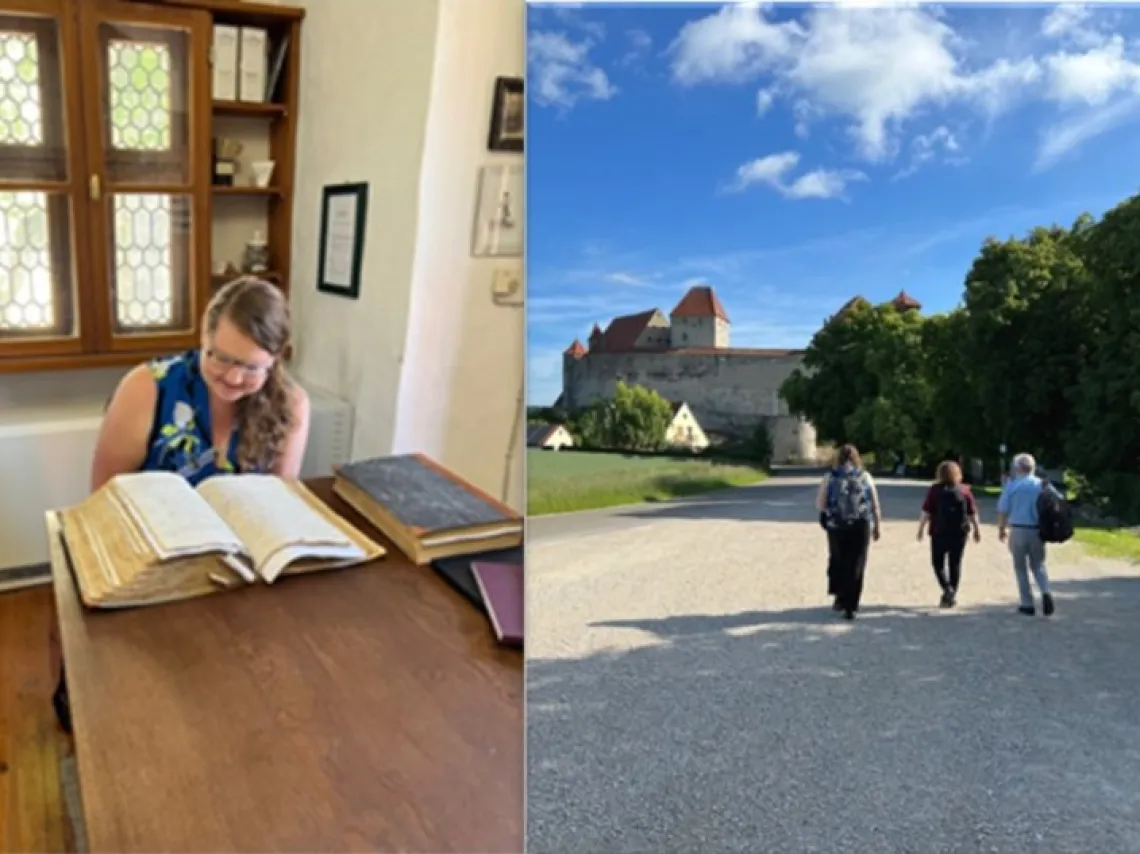From Digital Map to Physical Street

Abby Gibbons examining documents and on her way to do research at the Harburg Castle.
When I arrived in Munich and Augsburg, similar scenes of raging storms and pouring rains greeted me. I could not see the tall cathedrals of the Frauenkirche or St. Ulrich’s church, winding streets, or historic buildings. Instead, I worked on blinking the rain out of my eyes and keeping my head covered. Living in Tucson for the past year caused me to forget about the existence of rain. Unequipped for the weather and determined to get to my accommodations, I raced along the cobblestone walkways. Only when the rain cleared and I dried off did I see the many churches and cathedrals, the city halls, and the winding streets lined with historic buildings.
My dissertation research considers the intersections of violence, space, and social networks. I am interested in analyzing the violence between people who knew each other in hidden spaces and the networks involved in court cases that followed. Walking down the same routes that the people who I study walked five hundred years ago brings my research to life by introducing me to the spaces they inhabited. For all the modern reconstruction following World War II, Augsburg has retained much of its original footprint from the sixteenth century.
Signs throughout the city indicate what is new and old, reconstructed and original, and the scars of past centuries remain embedded in building facades. As I wandered through the city’s many passages during my first days in Augsburg, I came to understand how easy it was to move between well-populated spaces and those hidden from public view. What public and hidden meant and means also varies depending on the time of day and the weather conditions.
It is not just space and time that made a difference in my court cases. Just as important is who the people involved in violence were. The overlapping spaces that different groups inhabit then and now also mattered. For instance, the Fuggerei, now home to a popular beer garden and visited by crowds of tourists, is also where recipients of a charitable foundation established 500 years ago lived and still live. It thus stands as an active testament to the Fugger’s long-standing influence in Augsburg and to continued social and economic diversity. Guilds that were central to the sixteenth-century economy in Augsburg left their marks as well. The canals that the city government run by guildsmen built to perform silversmithing, leather production, and other trades crisscross the city. The water continues to flow, and one can still find the former houses of silversmiths and tanners along its path.
Beginning my dissertation research after studying Germany for several years from the U.S. brings me as much joy and excitement as one might imagine. The giddiness I felt flying into Munich and arriving in Augsburg has not yet dissipated as I walk into the archives ready to seek glimpses of the people who once lived here. The archives themselves each have their own personality. I will work in three during the duration of my stay: Augsburg City Archives, Nördlingen City Archives, and the Archive of the Counts of Oettingen-Wallerstein in the Harburg Castle. In cities, towns, and castles, I have had and will continue to have the pleasure of reading documents from the sixteenth century for the first time in person. I am also learning how to work in various German archives. My initial blurred vision from both the rain and inexperience is beginning to clear day-by-day, and I am excited to see what this next month has in-store—or rather in-archive—for me.
##
“From Digital Map to Physical Street” was published in the Spring/Summer edition of the “Desert Harvest,” published by the Division for Late Medieval and Reformation Studies. Abby Gibbons is a Ph.D. student in the Division for Late Medieval and Reformation Studies.

